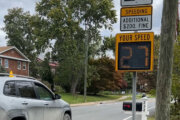Editor’s note: WTOP has brought back this 2018 story that continues to be relevant for this season. Enjoy!
This weather is for the birds!
If you think it’s been cold lately, think about being a wild bird out there in almost-Arctic weather.
Yes, the birds that spend the winter in our region do have many physical abilities that help them survive — they isolate the blood supply in their legs so it doesn’t chill the rest of their body; by keeping their feathers clean, they create an insulating blanket of warm air next to their body; they snuggle up with others of their species; and their high metabolism helps keep them warm.
But that metabolism has a price, and the price is food. Those cute little chickadees, for instance, need to eat a third of their body weight every day; and they need that food to be high in fat and high in protein over the winter.
Don’t feed seed
So far this winter (which does not even officially begin for another week) has been for the birds — at least it should be. I’ve been raising more than a few eyebrows over the years by advocating not feeding wild birds in the spring and summer, but I strongly advocate winter feeding.
Feeding birds in warm weather is not a good idea because:
- It fills their bellies when they should instead be eating your garden pests.
- It may interfere with young birds’ ability to learn to find their food in the wild.
- Any spilled seed attracts rats, mice, voles, and deer — and the evil squirrels that probably spilled most of the seed.
None of those issues apply in the winter, however, when feeding the right food is good for the birds and your gardens.
Rendered beef fat — yum!
Although feeding wild birds in the spring and summer can have negative consequences, feeding them during the cold days and nights of late fall and winter is good for the birds, and your garden, if you provide the right kind of food, and in a word, that’s suet.
In its most basic form, suet is a square cake of rendered beef fat, sized to fit into standard suet holders — metal cages that swing open to receive the suet cake and then snap shut to hold it in place. The cages can be nailed to a tree or hung from branches or shepherds’ hooks.
If you have a veggie garden in the summer, hang a few right in the middle of the beds — I’ll explain why in the next Plot. But feel free to also hang lots of the cages where you can see them from inside the house; the birds put on quite a show!
Suet now means fewer pests next summer
I always get in trouble when I say this, but I don’t like the use of seed feeders for wild birds. The spilled seed attracts and feeds vermin like rats and mice, landscape-destroying deer and evil squirrels.
Suet feeders, however, pose no such problems; in fact, they have a wonderful and unexpected side benefit. By placing lots of these feeders around your landscape, you’ll attract the best of the pest-eating birds, like chickadees, wrens, swallows, vireos and woodpeckers — just to name a few of the birds whose spring and summer diet consists of 85 percent or more of insect pests.
Suet cakes are the perfect winter substitute for those bad bugs, so hang lots of ‘em around your plants. Then stop refilling them when spring bulbs appear. The birds will not go away; they’re already nesting and raising a family at your place and will quickly turn their attention to eating your awakening insect foes.
The right stuff
Feed the right birds with the right food now and those birds will make nests, lay their eggs and feed their hungry little babies with your garden pests in the spring and summer.
The right food is suet — available wherever any kind of bird food is sold. There are many “flavors” out there (some cakes have added nuts, dried fruits and the like), so look at the ingredient list. You want the cakes with the highest amounts of fat and protein.
And a little something for the (evil) squirrels
Sometimes suet cakes do attract the unwanted attention of evil squirrels. To deter this, I seal the cage opening extra tight with twist-ties (actually I use those thick twist-tie-like things they use to fold over bags of coffee beans as you use them) and I sprinkle the suet with hot pepper — which wild birds actually love. (Hot peppers are one of a wild bird’s favorite foods; and it actually helps keep them warm over winter.)
You can also buy ready-made hot pepper suet cakes designed to appeal to birds and repel unwanted eaters.
Stale bread is for stuffing, not birds
Whatever you do, do not feed stale (or fresh) bread to your birds. Yes, they will eagerly eat it. And yes, it will quickly fill them up. But it is essentially devoid of the fat and protein they need to make it through winter. Feeding nothing at all is much better for your birds than feeding them bread.
Mike McGrath was editor-in-chief of ORGANIC GARDENING magazine from 1990 through 1997. He has been the host of the nationally syndicated public radio show “You Bet Your Garden” since 1998 and WTOP Garden Editor since 1999. Send him your garden or pest control questions at MikeMcG@PTD.net.







